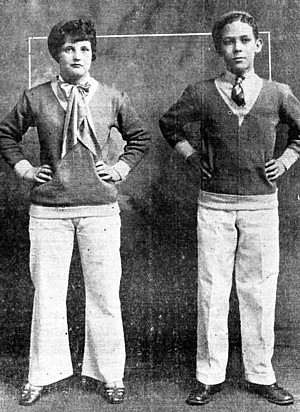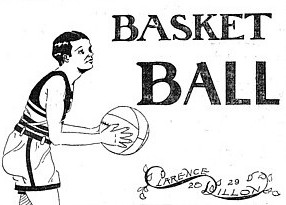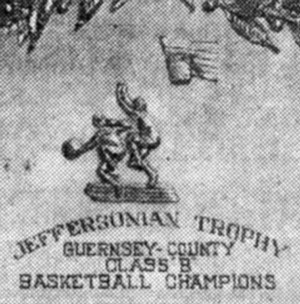Byesville
High, Part 2
Written
July 7, 2009
|
Background: I'm serving as ghostwriter for my late mother's "memoir" of her high school days in Ohio from 1927 to 1931. My main source: the 23 issues that she saved of the Byesville High School student newspaper, The Blue and White. In Part 1, Ann Buckingham told about such matters as the principal and the radio fad. There was also a column she wrote for the paper about the unruly crowd at a basketball game. In Part 2, we return to the only sport that mattered at BHS: hoops! |
Our home gym back in Byesville wasn’t as big as the one in Cambridge, but the basketball players thought it was pretty nice. We could seat 500 people, with another hundred on the stage if necessary.
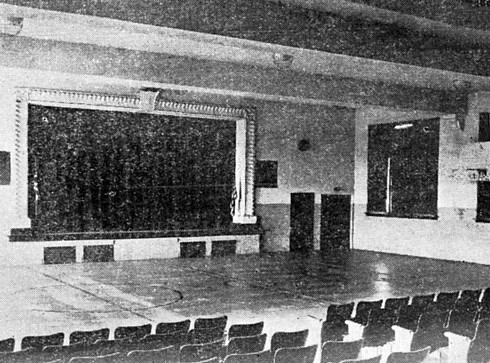
The floor was only 60 feet long and 40 feet wide, but there was room for out-of-bounds on all sides. There were steel braces to support the baskets and backboards. And in 1929, the boys in the Manual Training Department built a scoreboard to set on the stage. It was two feet high and five feet wide, and it showed the score, the quarter, and the time to play.
Downstairs under the gym, there were two showers. We had one dressing room for the home team and a separate one for the visitors, so Coach didn’t have to worry about the other team overhearing his strategy.
In the spring of 1929, they held a secret ballot of the whole school to vote on who was the “Most Conceited Sophomore” and titles like that.
Bernard
Heskett, the manager of the basketball team who talked on the radio,
was the “Most Popular Boy.” He was also the president
of the Class of 1930. (See, Tom, you don’t have to be an
athlete to be popular. Even the team manager can make it.)
Note from
Tom: My mother is being disingenuous here. At the time, a sheik
was "a man held to be irresistibly attractive to romantic young women."
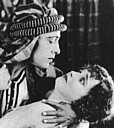
Presumably the
word came from the first modern romance novel, E.M. Hull's The
Sheik
(1919), which led to Rudolph Valentino's movie of the same name (1921).
A freshman, Durward McKee, was the “Biggest Sheik.” I guess that’s a good thing. I think it means he was a sharp dresser.
And whom did the students choose as “Prettiest Girl?” Why, that was me, Ann Buckingham! Thank you very much.
The next year, all three of the people I’ve named won in the same categories for a second time.
The year after that, when I was a senior, Bernard had graduated, but Durward was again the “Biggest Sheik” as well as the “Sportiest Junior” and the “Most Popular Boy.” And, for the third year in a row, I was voted the “Prettiest Girl.” Thanks again.
Besides going to basketball games, what else did we do for fun in Byesville? Well, there was a movie theater in town, the Luna Theater. One of their ads must have been written by someone who didn’t like French, judging from the way they spelled “vaudeville.” It says that on Tuesday at 6:15 and 8:30 the Luna would showing “7 Acts of Vodvil in Synchronized Talking Pictures.”
|
And here are a couple of pictures of fun times during the summer of 1929. I'll have to admit, it's not easy to make tennis racquets sound like ukuleles, but we tried. |
|

JUNIOR YEAR
In the fall of 1929, they held the fifth annual Prince of Peace Declamation Contest. I was one of the 14 chosen from Byesville High School. We each had to memorize a speech. They split us up into three groups. Each group went to a different church. The one from each group who gave the best speech got to go on to Cambridge for the next level, and eventually to the state finals. I didn’t win. But I did make the honor roll that month in public speaking, so there!
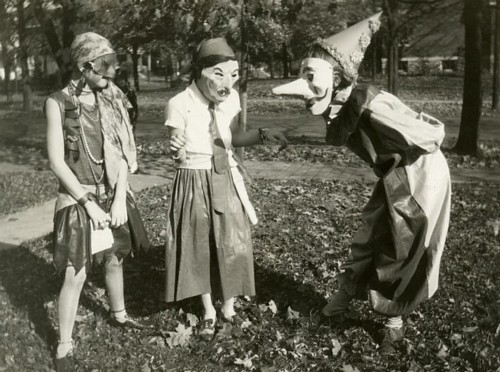
We had a big party on October 30, the night before Hallowe’en. (The picture above, showing costumed girls in that fall of 1929, is actually from Cincinnati.) The faculty planned it all out. After costume judging and fortune telling, they took us into a dark room and passed things around to us. I think they were vegetables like a cooked head of cauliflower, a peeled tomato, some baby carrots, and a couple of grapes, but they told us we were handling parts of a dead teacher, like his brain and his heart and his fingers and his eyes. In the dark, these things felt like real body parts, all squishy and gooey. You should have heard us screaming! Even the boys. It was a constant din. When we got out of that room, we all took deep breaths of relief.
The next night was the parade. Byesville was famous for its Hallowe’en parade. It followed a figure-8 route that started and ended in front of the high school on East Main Street. The marchers didn’t go down the street where our family’s dairy plant was, but they did pass a lot of the other business places in town.
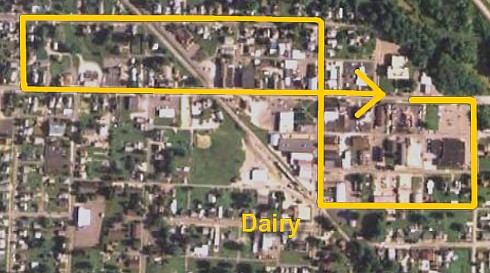
In the 1929 parade, we juniors wore Navy costumes and had a big float that was supposed to look like a Navy cruiser, with “Class of 1931” and “Juniors” on the sides. Our class won the high school prize. There was a big crowd, not only from Byesville but from all the towns around.
After that, it was time for the school play. The school newspaper gave us a good review, as they always do. After all, the paper is written for the students, and the writers always compliment their readers. Here it is. I’ll just skim through it.
The play Applesauce was presented before a large audience in the Auditorium of Byesville High School, Friday evening, November 22, 1929, under the direction of Miss Ila Nicholson, Dramatic Instructor of the high school. ...Miss Nicholson had not only a good cast but also a competent technical staff. ...Ann Buckingham, as assistant to the director, had the responsibility of prompting and all “off stage” business.
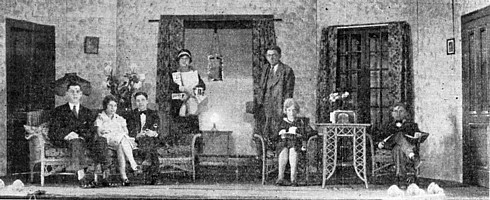
I actually wanted to perform, not stage-manage, but for that I would have to wait another few months.
While all this was going on, no one missed a day of school. That pleased the administration a great deal. There were 205 students in the high school, and all of us had perfect attendance for the entire month of November.
On the 13th of December, our basketball team started the 1929-30 season with a real thriller over at Cambridge. We lost 25 to 23 in double overtime. Here’s a writeup from the Cambridge paper, the Daily Jeffersonian.
Coach Gardner’s Byesville quintet was slow getting started but put up a stiff fight against their foes at all stages of the game. The outcome of the battle was extremely in doubt until Finney, a Cambridge substitute, sunk a pretty field goal late in the second overtime session, bringing victory to the Brownies.
Cambridge took a 9 to 5 lead at the quarter and held a 15 to 10 margin at the half. Morrow, the only regular left from last year’s Cambridge team, and Patton, one of the mainstays at forward, were forced out of the skirmish because of personal fouls. The Brownies registered ten field goals and five out of 11 free throws, while Byesville caged eight field goals and seven out of 20 from the gift point line.
With two minutes to play and the score standing 21 to 19, Byesville registered from the field, knotting the count. In the first overtime period Betts, Cambridge, and Peyton, Byesville, delivered buckets. In the second extra session numerous shots at the hoop were missed by both teams before Finney brought the struggle to a close with his field goal.
Notice how the only statistics were the ones from the scorebook? Points, field goals made, and free throws made and attempted; nothing more. Nowadays people keep track of all sorts of other numbers: missed field goals, turnovers, rebounds, assists, all of that.
My favorite player was Durward McKee. He’s in the middle row of this team picture, third from the left. During that season, Durward also made the Honor Roll for December 1929 in Vocational Guidance, and for February 1930 in Community Civics.

By the way, one name that almost always appeared on the Honor Roll was Athel Unklesbay. He was the salutatorian of the Class of 1930. I always thought he had a funny name. “Unklesbay” sounds like pig Latin for “Buncles.” But his family had been around for a long time. Back in the log cabin days, Byesville’s first postmaster was Zack Unklesbay.
Another unusual name belonged to a boy in my class who later was voted “Most Dignified Senior,” Welcome Woodrow Reed. I never asked, but I suppose he could have been born six weeks after me, in March of 1913. If so, Mr. and Mrs. Reed could have named the new baby “Welcome Woodrow” as their way of welcoming Woodrow Wilson to the White House!
|
|
Here's our Byesville High School cheerleading squad for 1929-30. It consisted of Betty and Bill. Our “Cheer Leaders” were Betty Tucker, a freshman, and William Finley, a junior like me. I did mention that we were a rather small school, didn't I? But in those days it was not unusual to have only one pair of students leading the yells. I found a 1916 football story in the Richwood Gazette: “The game was very interesting at all times, and the high school cheerleaders Margaret Collier and Thaddeus Roebuck kept the student body going.” |
For students who didn't make the varsity team or the reserves, intramural basketball was also available, although I didn't participate. The school held a big class tournament every March, with boys’ and girls’ teams from each of the four classes competing against each other. The nine girls from my junior class won the girls' trophy cup for 1930.
One Monday night, the varsity coach put on a slide show for his players. He had about 75 slides from the athletic department at the University of Indiana, and they showed the proper way to do all the fundamental things: shooting, passing, pivoting, and the rest. However, the boys said afterwards that the slides didn’t teach them much that they didn’t know already. That just confirmed that they’d been taught the best up-to-date techniques, according to the leading authorities.
|
|
Back then, players used both hands to shoot the ball. The jump shot hadn’t been invented yet, and no one was tall enough to even consider dunking. So the scoring was much lower than it is today. Making a basket was a big deal. If someone did manage to score, the two teams went to center court for a jump ball, just like hockey and soccer teams do after a goal. |
Although a high-scoring game was unusual, we did tally an amazing 65 points against Buffalo that season. Of that total, 48 were scored by our first string even though they played just 16 minutes, only the first and third quarters. Buffalo wasn't very good.
Another opponent, Lore City, was in its first season of basketball. Their boys hadn’t quite learned the game yet, and they managed just six points against us for the whole night.
When the 1930 Guernsey County Class B tournament began at the end of February, BHS had a record of seven wins and five losses. There were a total of seven schools entered in the tournament. Four of them also sent girls’ teams, but not us.
To open the tournament on Friday night, our boys outclassed Buffalo again, 46 to 10 this time. In the semifinals, we edged Cumberland 18-16. That put us into the championship game on Saturday night, against Senecaville.
It was a close game, and I can confirm the description in The Blue and White: “a thrilling contest which kept the large crowd of followers of both teams in an uproar throughout the entire melee.” We were tied at halftime and won by a single point, 28-27.
|
Our leading scorer was our junior center and best rebounder, Paul Peyton. He had 41 points in the three tournament games, including 13 in the final. We won a trophy cup and also became the first team to be awarded the new plaque called the Jeffersonian Trophy. |
|
After that, we moved on to the Sectional Tournament, which was also held in Cambridge. We had high hopes of winning that one too and making it all the way to the District Championship. Our slogan was “On to Dennison!” But we won only one game in the Sectional before we were eliminated.
Nevertheless, we were the county champions. The Phi Delta Kappa fraternity gave the team a big banquet in May at the Colonial Inn in Old Washington.
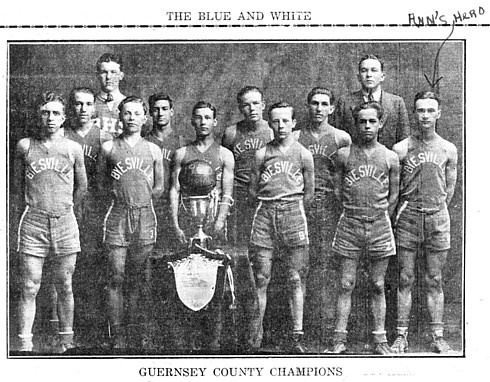
Durward McKee is the one on the right in this picture, with an arrow pointing him out as my “hero.” He scored only nine points all season, none in the tournament. But he was just a sophomore that year, a year younger than me, and he was the only sophomore on the varsity.
Durward was president of the Class of 1932, so he got to stand in the front row of his class pictures. Here he is as a freshman, sophomore, and junior.
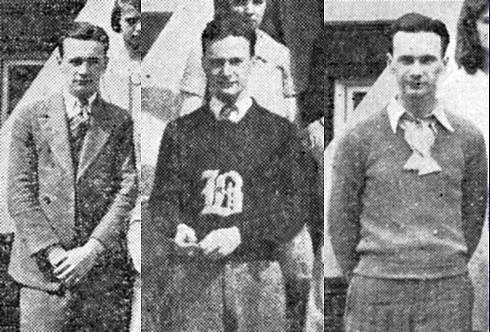
Durward and I became something of an “item.” Some say that he and I were inseparable. Two months before I graduated, The Blue and White ran a column called “Just Imagine” — listing such fantasies as Coach Garner smiling, James Wilson saying something sensible, Lucille Farrar without lipstick, Bill Culbertson in a hurry, Albert Ryan becoming excited about anything, and the auditorium being heated when the Public Speaking Class wanted to use it — and one of the improbable scenarios that readers were supposed to imagine was “Ann Buckingham without Durward McKee.”
But that was high school. Durward moved away; to Lexington, Kentucky, as I recall. Thirty years later, you and your father and I were driving somewhere, and we were passing through Lexington. Your father teased me and asked if I didn’t want to look up my old boyfriend. I declined.
|
The narrative concludes in Part 3, with stories of plays, poetry, and humor. |

